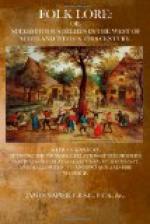CHAPTER X.
MISCELLANEOUS SUPERSTITIONS.
Glamour was a kind of witch power which certain people were supposed to be gifted with; by the exercise of such influence they took command over their subjects’ sense of sight, and caused them to see whatever they desired that they should see. Sir Walter Scott describes the recognised capability of glamour power in the following lines:—
“It had much of glamour might,
Could make a lady seem a knight.
The cobwebs on a dungeon wall,
Seem tapestry in lordly hall.
A nutshell seem a gilded barge,
A sheeling seem a palace large,
And youth seem age, and age
seem youth,
All was delusion, nought was
truth.”
Gipsies were believed to possess this power, and for their own ends to exercise it over people. In the ballad of “Johnny Faa,” Johnny is represented as exercising this power over the Countess of Cassillis—
“And she came tripping down
the stairs,
With a’
her maids before her,
And soon as he saw her weel
faured face,
He coost the glamour
o’er her.”
To possess a four-leaved clover completely protected any one from this power. I remember a story which I heard when a boy, and the narrator of it I recollect spoke as if he were quite familiar with the fact. A certain man came to the village to exhibit the strength of a wonderful cock, which could draw, when attached to its leg by a rope, a large log of wood. Many people went and paid to see this wonderful performance, which was exhibited in the back yard of a public house. One of the spectators present on one occasion had in his possession a four-leaved clover, and while others saw, as they supposed, a log of wood drawn through the yard, this person saw only a straw attached to the cock’s leg by a small thread. I may mention here that the four-leaved clover was reputed to be a preventative against madness, and against being drafted for military service.
One very ancient and persistent superstition had regard to the direction of movement either of persons or things. This direction should always be with the course of the sun. To move against the sun was improper and productive of evil consequences, and the name given to this direction of movement was withershins. Witches in their dances and other pranks, always, it was said, went withershins. Mr. Simpson in his work, Meeting the Sun, says, “The Llama monk whirls his praying cylinder in the way of the sun, and fears lest a stranger should get at it and turn it contrary, which would take from it all the virtue it had acquired. They also build piles of stone, and always pass them on one side, and return on the other, so as to make a circuit with the sun. Mahommedans make the circuit of the Caaba in the same way. The ancient dagobas of India and Ceylon were also traversed round in the same way, and the old Irish and Scotch custom is to make all movements Deisual, or sunwise, round houses and graves, and to turn their bodies in this way at the beginning and end of a journey for luck, as well as at weddings and other ceremonies.”




